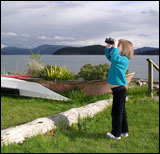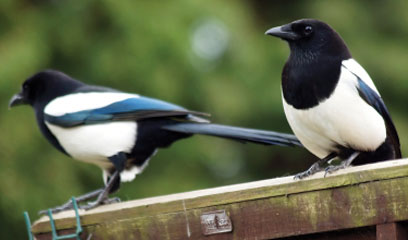 Check out our activities for kids for birding and family-friendly nature activities near you.
Check out our activities for kids for birding and family-friendly nature activities near you.
"Heron!" shouts my 5-year-old daughter, and we run out onto the back deck as a great blue heron, a seasonal resident of a nearby ravine, flies low overhead with the ponderous power of a B-52 bomber.
My daughter recognizes all of the birds that are regulars in our neighborhood, from the gang of brilliant blue Steller's jays that congregate in our back yard to the tiny bushtits whose mossy, conical nest dangles from a flowering cherry branch out front. I've pointed out osprey and eagles to her since she was small, and we've always gone on bird walks with her older brother, but the intensity of her interest in birds has always surprised me.
Maybe it shouldn't.
Children and nature
"Kids have an instinctive fascination for nature," says Stuart Wechsler, a naturalist who began birding intensively at age 11 and who now leads nature walks at Seward Park and Camp Long. "If it's not nurtured, it will die a slow death...any kid who's exposed to nature, preferably with someone with knowledge and passion, will get into it almost universally."
When Wechsler began birding in the late 1960s, it was still considered to be something of an oddball interest. Since then, it's shed that reputation in a very big way. The latest National Survey on Recreation and the Environment (NSRE), released by the USDA Forest Service in 2000, found that watching birds was the fastest-growing outdoor activity in the country, attracting some 70.4 million participants ages 16 and over.
It may no longer be considered eccentric, but birding still has a reputation for being - and is, in fact - a primarily adult pursuit. And that's a shame. In an era when urban and suburban children's under-exposure to the natural world is starting to be understood as a problem, bird watching is a low-cost, easily accessible way to experience an outdoor activity with kids. It engages their minds and their senses, allows for free exploration and can be adapted to the needs of any age.
Backyard bird watching
You don't have to travel to some distant location to find birds, either. Although Washington's birding "hot spots" draw enthusiasts from all over, looking out the window onto an urban backyard can work just as well for beginners. "What other animal do you see every day?" asks Susan Tallarico, Education Director at Seattle Audubon. "You can see an amazing variety in your backyard by just putting up a feeder."
Tallarico calls bird watching "an amazing holistic tool" for the introduction of a host of topics that include geography, botany, conservation and environmental issues. A glimpse of a striking Western tanager at Seattle's Discovery Park can lead to a discussion of the importance of habitat conservation to the species' survival, or the role American consumers play in the preservation of habitat through the purchase of shade-grown coffee. Bird behaviors are also often on easily observed display, which is far more compelling to most kids than simply reading about them in a book or online.
May is an especially good time to start birding with kids as area woods and parks play host to colorful migratory birds that are up for the breeding season from their wintering grounds in Central and South America (see below). It's exciting to spot an unusual bird, and that excitement can spur kids to make new discoveries about the natural world. "It's about making a connection," Tallarico says. "[It's about teaching] kids to have a healthy relationship with a creature that is truly wild. It's all about making it relevant and local. And you don't get that with studying other animals."
Kris Collingridge is ParentMap's Out & About editor.
 On the fly: Celebrate International Migratory Bird Day
On the fly: Celebrate International Migratory Bird Day
They're often so tiny and delicate-looking that their flight across the Americas, undertaken by night in huge flocks that pass almost unnoticed overhead, seems like a nearly impossible physical feat. In spite of their hardiness, many species of migratory birds are in decline due to habitat loss. International Migratory Bird Day was created in 1993 by the Smithsonian Migratory Bird Center and the Cornell Laboratory to call attention to the birds' journey and to the urgent need for habitat conservation. Visit an area IMBD event to learn about migratory birds, local birding resources and conservation in a kid-friendly format. These events recur yearly during the first two weekends of May.
- Woodland Park Zoo's Festival for the Birds includes kids' activities and bird demonstrations in the Family Farm. Free with admission.
- Migratory Bird Weekend at the Seattle Aquarium includes demonstrations, crafts and special talks, and is free with admission.
- Migration Madness at Northwest Trek introduces kids to birds with bird-themed games and crafts, contests, birding skills instruction, live owl viewing and more.
- Edmonds' annual Puget Sound Bird Fest (held in September) features guided walks, kids' activities, bird-watching stations and workshops. Most activities are free.
- The Backyard Wildlife Festival in Tukwila is an IMBD event that focuses on other wildlife in addition to birds. Includes a Procession of the Species parade, workshops, kids' activities and music.
Getting started: Family bird walks
Joining a naturalist-led group bird walk is an excellent way for beginners to polish their skills with help from an expert. Bird walks are typically offered throughout the month of May.
- Seattle's Seward Park offers bird walks for all ages in May.
- Discovery Park in Seattle also hosts May bird walks for families with kids ages 8 and up.
- Families, beginners and non-members are welcome at Seattle Audubon's free Neighborhood Bird Walks, which happen on Saturdays (often year-round) at locations around the greater Seattle area. www.seattleaudubon.org.
- Seattle Audubon's yearly May Birdathon fundraiser often features a family bird walk or two.
Try before you buy
Seattle Audubon rents a Family Field Pack that contains everything you need to start birding: adult and child binoculars, field guides, flash cards, maps, bird checklists and an excellent booklet for beginning birders. Family Field Packs can be reserved by emailing kits@seattleaudubon.org. The booklet, Sharing Birds with Young People, can also be downloaded and it's well worth doing so.
 10 tips for birding with kids
10 tips for birding with kids
1. To avoid frustration, help the kids practice using their field guides and binoculars before you go out.
2. Remember that you don't have to be a bird expert to help your kids learn. Learning together as a family is a valuable experience, and kids feel important when they're able to teach you something for a change.
3. Dress for weather and wear comfortable shoes.
4. Bring plenty of snacks and water.
5. Keep it fun! If your children are growing tired or bored, turn around.
6. Learn and use birds' real names.
7. Help kids learn to observe birding ethics, the most basic of which is to observe birds without significantly disturbing them. That means using low voices, not chasing birds and staying away from nests and feeding areas.
8. Point out birds wherever you are to help your child remember names and to help her get in the habit of observing her environment.
9. Buy a feeder for your backyard, or build one with the kids. Let them help fill it and put it up, and keep track of the birds that visit your yard.
10. Always keep a pair of binoculars close at hand at home so you don't have to hunt them down when you need them.
Purchasing bird watching equipment
Choosing binoculars can be time-consuming and confusing for the beginner. As a general rule for kids, choose binoculars that are rugged and of decent quality. Avoid toy binoculars. Many binoculars can't be adjusted to properly fit children's smaller faces, according to Seattle Audubon's Susan Tallarico, so try them out before you buy. Using uncomfortable equipment is a fast way to turn a child off to birding. The Seattle Audubon Nature Shop carries a wide range of optics and a general guide to choosing binoculars. For kids and beginners, the Cornell Lab of Ornithology's online nature shop recommends the Audubon Binocular 4x30 and the Audubon Binocular 8x40, both which are under $100 and available at Binoculars for Birders Shop.
Find a field guide that is easy for kids to use. Tallarico recommends the Stokes Beginner's Guide to Birds, Western Region, a pocket-sized book that Seattle Audubon uses at its summer nature camps. Birds are grouped by color, making identification much easier for novices.
Download a local bird checklist, so you are aware of what you might see, and to keep track of your sightings. Seattle Audubon offers a kid-friendly checklist, Seattle is for the Birds.
Four great family bird walks in the Seattle area
These parks all feature flat, well-maintained trails and are easily accessible, close in and boast diverse habitats that attract plenty of birds.
Union Bay Natural Area: Located on Lake Washington, it's considered one of the city's best birding locations. Look for beavers, otters, nutria and turtles, too. Park at the Center for Urban Horticulture, located adjacent to the natural area at 3501 N.E. 41st St., Seattle.
Marymoor Park: Walk the interpretive wetlands path or internal trails. Over 150 bird species have been spotted here.
Juanita Bay Park: The boardwalk and interpretive wetlands trails are all good places to spot birds and offer stunning Lake Washington views. Download a wildlife guide and park map.
Discovery Park: The park's meadows, forest and beach are bird magnets. Check in at the Visitor Center for a beach parking pass, if you're with kids, and for information on where birds have been spotted lately.
 Should you be worried about bird-borne illnesses?
Should you be worried about bird-borne illnesses?
According to the World Health Organization, avian flu has not yet entered the United States. The Center for Disease Control considers the virus, which is carried in the intestines of wild birds, to be a relatively low health risk to humans. Although cases have been reported worldwide since 1997, these cases have resulted from close human contact with infected domesticated --- not wild -- birds, or with virus-contaminated surfaces. Visit the CDC's Web site for extensive information about the avian flu.
West Nile virus, a serious mosquito-borne illness, is carried in the blood of infected birds. So far in 2006, no cases have been reported in Washington State, and the risk of contracting the disease (which most seriously affects people over 50) is considered to be very low. The virus kills some of the birds it infects, mostly jays, crows, ravens and magpies. Although there isn't any evidence that the virus can be spread through direct contact, residents who find a dead bird are discouraged from touching it with their bare hands and should contact their local health department. Visit the Washington State Department of Health for more information.
Great websites and books for bird watching
Washington Audubon. Features Audubon at Home, which includes Kidspace pages with information about conservation, bird feeding, and making backyards welcoming to wildlife, as well as sensory activities for kids.
Smithsonian Migratory Bird Center. Games, information, coloring pages and activities for kids.
Take a Backyard Bird Walk by Jane Kirkland. A guide book for kids with hints and tips for close-to-home birding, recommended by Seattle Audubon's Susan Tallarico.
Flute's Journey by Lynne Cherry (Harcourt). Beautifully written and illustrated story book for younger kids about the life cycle of a migratory wood thrush, and the challenges it faces as its habitat is altered.











